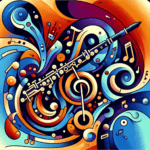Alright, clarinet enthusiasts! Let's talk about the C# augmented scale, a real gem in clarinet music. Most of us know about the traditional scales, but this one jazzes things up and has some fun history behind it! So, why should we even care about the C# augmented scale? Well, it's been shaking up the jazz scene and classical concerts for ages. Let's explore what makes it so special!

Clarinet Fingering Charts are always FREE at MartinFreres.net!
The Composition of the C# Augmented Scale
The C# augmented scale consists of the notes C#, E, F, G, A, B, creating a unique blend of sharp notes that add spice to your melodies. It sounds absolutely fantastic! If you're into jazz music, you might have noticed this scale popping up during improvisations, allowing players to create melodies that catch listeners off guard in the best way possible.
Historical Context: Jazz and Beyond
Let's look at when this scale really took off. As jazz emerged in the early 20th century, musicians started experimenting with harmony and scales. The C# augmented scale became a go-to tool for improvisation. Imagine big band leaders like Duke Ellington or orchestral wizards like Igor Stravinsky weaving it into their works. It brought a fresh perspective to the music of the time.
| Era | Musical Style | Notable Musicians |
|---|---|---|
| Early 20th Century | Jazz | Duke Ellington |
| Mid 20th Century | Classical | Igor Stravinsky |
| Late 20th Century | Contemporary Classical | Aaron Copland |
Classical Applications of the C# Augmented Scale
But here's the kicker – the C# augmented scale isn't just for jazz lovers! It struts its stuff in classical compositions too. Check out works by Claude Debussy or Aaron Copland, and you'll spot this scale adding a touch of color and sophistication to their pieces.
Applying the Scale on Clarinet
Now, let's talk about how to use this scale on the clarinet. When you practice, focus on getting comfortable with those intervals. The upper raised notes against the base tone create fascinating harmonic possibilities. It's not just about playing the notes; it's about expressing emotions through rich soundscapes. From sad tunes to joyful outbursts, the C# augmented scale can handle it all!
Composition Tips for Aspiring Musicians
For you budding composers out there, let's chat about creativity! Using this scale in your pieces can spark fresh ideas. Try taking familiar themes and giving them a twist with the C# augmented scale. Imagine a piece that starts smooth and suddenly shifts into an energetic riff – your audience won't know what hit them! With today's ever-changing music scene, using unique scales like this can really make your compositions stand out.
Overcoming Challenges with the C# Augmented Scale
Let's talk about the hurdles clarinetists often face with the C# augmented scale. At first, it might feel like you're juggling too many balls. But don't worry! With practice, you'll find the rhythm and speed start to flow naturally. And here's a pro tip: play around with dynamics! Changing the volume on certain notes can really bring out the beauty of those augmented intervals.
The Historical Significance of the C# Augmented Scale
The C# augmented scale has a special place in music history. Musicians have long used its unique character to express their deepest thoughts and stories through melody. It offers a kind of musical freedom that's perfect for connecting with audiences on a deeper level. The magic that comes from experimenting with this scale has inspired musicians for generations and continues to do so today.
Wrapping Up: The Impact of the C# Augmented Scale
To sum it up, the C# augmented scale is more than just a series of notes – it's a musical bridge connecting generations of artists. Next time you pick up your clarinet, give this scale a try! Think about its rich history and embrace the impact it can have on your playing.
There you have it! The C# augmented scale is so much more than just some funky intervals – it's a slice of music history that's still making waves today! Start practicing it, fellow clarinetists, and watch your playing transform. Who knows? You might just inspire the next generation of musicians with what you create! Happy playing!
Table of Contents
- Introduction
- The Composition of the C# Augmented Scale
- Historical Context: Jazz and Beyond
- Classical Applications of the C# Augmented Scale
- Applying the Scale on Clarinet
- Composition Tips for Aspiring Musicians
- Overcoming Challenges with the C# Augmented Scale
- The Historical Significance of the C# Augmented Scale
- Wrapping Up: The Impact of the C# Augmented Scale








